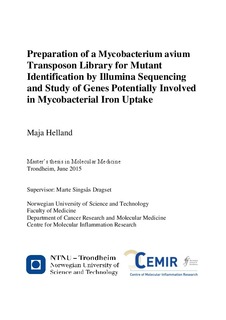| dc.description.abstract | Mycobacterium tuberculosis is a serious health problem worldwide, and cannot be conquered without an efficient vaccination strategy. Today there are no efficient vaccines available, and it is thereby urgent to develop new ones. M. tuberculosis is also acquiring resistance to an increasing number of antibiotics, which has even lead to a M. tuberculosis strain that is totally drug-resistant. Consequently, it is crucial to develop new drugs to deal with this threat. To develop new vaccines and drugs it is important to identify and validate new potential mycobacterial drug targets.
Mycobacterium avium shares many properties with its relative M. tuberculosis, such as ability to establish infection within macrophages. M. avium can also cause severe infections, particularly in immunocompromised individuals. Although M. avium can serve as a model organism for studying tuberculosis, it is therefore also a bacterium that absolutely needs research attention by its own.
To contribute towards the development of new and effective drugs and vaccines against pathogenic mycobacteria, the specific aim of this study was first of all to organise an M. avium transposon mutant library of around 10 000 mutants, and prepare it for Illumina sequencing, in a way that mutants with specific insertion sites could be easily identified in a future application of the library. Such an organised library would make it easy to pick out interesting mutants for further investigation and also to conduct screenings of many thousand mutants at the same time and study their phenotype under different conditions.
Secondly, this study aims to investigate selected genes potentially involved to mycobacterial iron uptake. In drug development it would be of interest to target parts of the mycobacterial iron uptake system, which is essential for the mycobacteria to survive. For this aim, growth curve analysis of non-pathogenic model organism Mycobacterium smegmatis with gene potentially involved in iron uptake knocked out were performed in media containing various iron concentrations.
Mutants organised and prepared for Illumina sequencing were sent for Illumina sequencing at Texas A&M University, and sequencing results are expected to ready at the end of June 2015.
From the growth curve analysis performed, the result is that the genes msmeg_4898 and msmeg_4900 do not seem to be important for the mycobactin pathway in M. smegmatis. However, this does not mean that they are not important for this purpose in other mycobacteria. | nb_NO |
